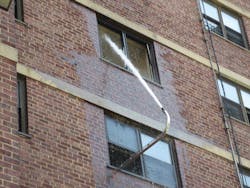Firefighter Training: The High-Rise Nozzle At Commercial & Residential Fires
During a recent update and revision of high-rise procedures in residential and commercial office high-rise buildings, Jersey City, NJ, Fire Department (JCFD) members also received training in the difficulties of fighting wind-driven fires in high-rise buildings. Part of this training included the use of the New York high-rise nozzle, which was recently assigned to a number of companies throughout the city (Photo 1).
Reviewing information presented by the National Institute of Standards and Technology (NIST) in coordination with the FDNY (which has placed 58 of the nozzles into service) and the Chicago, IL, and Toledo, OH, fire departments, a comprehensive program was presented by the JCFD for its members so they could prepare for this challenge. The training included numerous classroom exercises as well as hands-on training with the new equipment and associated procedures.
It was also during this process that JCFD members saw added value in the high-rise nozzle as a potential nozzle that could be used for difficult-to-reach fires in cocklofts and cellars in residential and commercial buildings.
Experience has often shown that fires that take possession of the cockloft or cellar area of our residential and commercial buildings can present operating forces with significant challenges. We know that the challenges of rapid fire spread in a cockloft or cellar focus on three specific areas of concern:
1. Our difficulty to quickly and efficiently open or access the space.
2. The fuel loads associated with either cockloft or the contents of a below grade area.
3. Our ability to apply water quickly and effectively on to and ahead of an advancing fire.
To assist our members with controlling an advanced fire that has extended into a cockloft, cellar, or even below a dock or pier on our waterfront, members of the JCFD were the given the added option of using a high-rise nozzle to slow the fire’s growth. But before this authorization was given, members also needed to be aware of considerations and pre-requisites before a cockloft/cellar nozzle could be used.
Considerations before nozzle use
Fires that enter or originate into concealed or difficult-to-reach areas such as a cockloft, or cellar create a high-pressure fire environment. When you attempt to open the space by either pulling the ceiling or opening a basement or cellar door, you are introducing a low pressure opening that the fire will seek. Because of this you need to:
• Seek permission from the Battalion Chief assigned to oversee the area in question and/or the Incident Commander.
• Coordinate the operation with interior, roof and exposure companies.
• Have another hose line available to protect members once the opening is made.
• Ensure/request multiple secondary means of egress are available.
• Do not operate over or directly under floors or ceilings areas whose integrity is already compromised.
• Be prepared for fire to exit the new opening you created.
• Be prepared to protect any exposure areas around the opening you created.
• Be mindful, your new opening will allow air to enter into the fire area increasing the fires growth.
• Be mindful that your new opening may let air enter into an air/oxygen-starved environment and create a backdraft.
Nozzle operations
High-rise nozzles are designed to be used with 2½-inch hoselines. If no 2½-inch hoselines are immediately available, 1¾-inch hoselines can be quickly modified to accept the new nozzles. Be mindful that high-rise nozzles are designed with a 2½-inch nozzle. If you attempt to attach a high-rise nozzle to a 1¾-inch hoseline/nozzle, you will need to add an adapter (Photo 2). JCFD Engine Companies 2, 8, 9 and 11 have been assigned adapters (orange colored) to allow a 1¾-inch breakaway nozzle to be quickly modified to accept a high-rise nozzle (Photo 3).
Before opening the nozzle, it must be supported against a ceiling joist or door jamb, or structural member in order to take up the nozzle back-pressure. Failure to do so will result in the nozzle/pipe pushing away and out of the opening.
When operating the nozzle, consider the angle designed within the bend/curve of the pipe. This will allow for maximum reach and penetration into the opening (Photos 4 and 5). Assign two members to the nozzle. If the hoseline team is going to be moving from room to room or area to area, consider placing an “in-line” gate back one length to assist with the movement. If this is not an immediate option, consider adding a length of hose to the fire attack nozzle and then place the high-rise at the end of that hoseline. The fire attack nozzle can then act as a shutoff.
In high-rise operations, the JCFD’s required use of two-inch or 2½-inch hose with 2½-inch couplings allows for an easy transformation with the high-rise nozzle at a wind-driven fire. However, we also realized that when we are “already digging-in” to a top-floor/cockloft fire in a row of attached frames or an H-type multiple dwelling, the hoseline of choice at that time will be the 1¾-inch line. To quickly adapt and get water into the space to slow the fire’s growth, the JCFD had adapters specifically machined to attach to a breakaway, smooth-bore nozzle to accept the cockloft nozzle. Are the hydraulics exact? NO. Does it look pretty? NO. But our initial concern was not the QUANTITY of the water, but the TIMING and QUALITY of the water application. If staffing permits, stretch the 2½-inch hoseline to the top floor of the building.
Michael Terpak presents “Fires in Lightweight Construction” at Firehouse Expo 2014.
